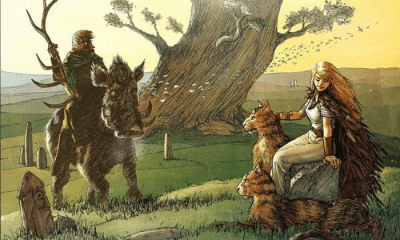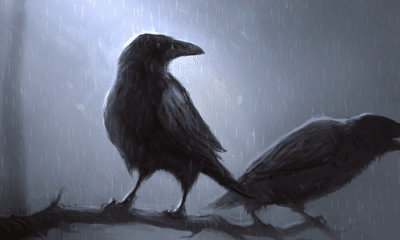
Norse
Who Was Sif in Norse Mythology?
Who Was Sif in Norse Mythology?
In Norse mythology, Sif was the golden-haired wife of Thor. There may be much more to her story than just her famous husband, however.
Like many characters in Norse mythology, not much is known about Sif. She was Thor’s wife, but because few myths survive in detail little else is known about her.
Sif’s most famous attribute was the long, golden hair that played a central role in her most well-known story. Even that tale, however, is less about Sif and more about how her husband reacted to the theft of her golden locks.
It’s also about what he and the other gods gained when that hair was remade. When Loki had the dwarves make new hair for Sif, they also made the most famous possessions of Thor, Odin, and Freyr.
Despite the lack of surviving stories, enough is said about Sif to provide some clues as to what her role was in Norse mythology. Rather than being just a wife, many historians now believe that she and her golden hair were far more important than they might seem.
Later writers might have seen her only as a more powerful deity’s spouse, but they provided enough clues to now interpret her as an aspect of a powerful and familiar archetype in mythology.
Sif’s Appearances in Norse Mythology
Sif was the wife of Thor, the Norse god of thunder.
Thor was a very important god in the Norse pantheon. He appears in many legends, his name was widely given to both places and people, and his famous hammer became the most identifiable symbol of the Viking Age.
As his wife, it would seem likely that Sif was important as well. Much less is known about her than is known about her husband, however.
This is due, in large part, to how few accounts remain of Norse mythology. Most of what we know comes from only two epics, called Eddas in the Norse language, that were written in the 13th century, hundreds of years after the height of the Viking Age culture.
We know that most of the characters and events of the Eddas were original to the Viking Age because they are depicted in surviving works of art, but the lack of written sources limits how much we really understand about the mythology.
In the Poetic Edda she appears at a feast of the gods and is mentioned briefly in a conversation between her husband and Odin. In the Prose Edda she appears, again only briefly, in the only known myth that features her, the story of how Loki stole her hair.
Thus, we know relatively little about Sif. The fact that she appears so little in the Eddas does not mean that she wasn’t an important goddess, however.
The Prose Edda, for example, deals largely with the creation and destruction of the world. The stories related often tie into these two events, so it’s likely that many more legends existed that did not tie into these specific events.
Greek mythology, for example, had many stories about the marriages and births of their gods. These stories may have also been told by the Norse people, but were not written down in sources that survive today.
For a goddess like Sif, who was not connected to the more martial themes of the events around Ragnarök, her stories may have simply not survived. She is remembered as Thor’s wife, but her role is otherwise unclear.
Even Sif’s name does not give any clues about what role she played in the pantheon. Sif roughly translates as relation, specifically someone related by marriage, so even this only tells us that she was the wife of one of the gods.
A Possible Affair
Although we know she was Thor’s wife, there are some clues in the Eddas that suggest that Sif was not necessarily a loyal and devoted spouse.
The personal relationships between the gods are often ambiguous in the surviving stories. Sif and Thor’s marriage is no different.
The stories that we have today seem to characterize Thor as a devoted husband. In fact, most references to Sif include her husband defending her from either insults or attacks.
But there are hints, however, that Sif may not have been as loyal to Thor.
In the Poetic Edda, for example, Loki arrives as a feast in Asgard and insults all of the gods, angering most of them. Sif remains calm and serves him mead, saying that there is nothing he can say to attack her because she has done nothing wrong.
Loki, however, does have an insult for Sif. He claimed that he alone knew her secret, which was that she was unfaithful to her husband.
In fact, Loki claimed that he was Sif’s lover. Sif does not respond to this claim.
Earlier in the Poetic Edda, it was implied that Loki was not actually the only one who knew about her infidelity.
Odin and Thor similarly exchange insults when Odin, in disguise, refuses to ferry his son across the bay. Such exchanges, known as flyting, were common in Norse and Celtic societies and combined wordplay with provocative insults in a contest of wits and nerve.
Among Odin’s insults is the accusation that Thor’s wife has a lover at home while he, Thor, is traveling on his many adventures.
Thor claims that the ferryman is lying. He calls him “witless” because the false accusation is meant only to be hurtful instead of clever.
Both gods declare a king of victory in the flying. Thor refuses to listen to what he calls lies, while Odin claims to have outwitted Thor by speaking the truth.
Other sources, including the Prose Edda and shorter poems, do not directly accuse Sif of infidelity. They do, however, say that she had a child who was not born within her marriage to Thor.
Ullr was a god known for his magic who was once said to have taken over the leadership of the Aesir when Odin was briefly exiled. Several sources describe him as being Thor’s stepson.
The father of Sif’s son is never named and Ullr is not featured in any myths. Like his mother, Ullr is among the gods who is referenced often enough to clearly have been important although his legends have not survived.
The fact that he is named as Sif’s son but not Thor’s, however, implies that there was more to Sif’s story than just her marriage to the god of thunder. Her very name may have marked her out as his wife, but the clues provided in surviving stories tell us that her personal life was likely more complicated.
Sif of the Golden Hair
Sif’s most famous story, however, is not one of an affair or an exchange of insults. Instead, she is most well-known for the story of how Loki stole her most defining attribute.
Sif was described as a beautiful goddess. She was well known for her long golden hair.
In the Prose Edda, the story is told of how Loki stole this hair. For no reason other than to cause mischief, the trickster cut off Sif’s hair as she slept.
The story does not say how Loki got so close to Sif when she was asleep. Some have taken this as evidence that, as the Poetic Edda claimed, Loki was her lover, while others believe he drugged Sif and Thor to pull his prank.
When Loki’s mean-spirited trick was discovered in them orning, Thor was furious. The poem says:
Why is gold called Sif’s hair? Loke [Loki] Laufey’s son had once craftily cut all the hair off Sif; but when Thor found it out he seized Loke, and would have broken every bone in him, had he not pledged himself with an oath to get the swarthy elves to make for Sif a hair of gold that should grow like other hair.
-Snorri Sturluson, Prose Edda (trans. Anderson)
Always able to find a way to escape from the trouble he had caused, Loki claimed that the dwarves could make new hair for Sif. The master metalworkers could create hair of real gold that would be even more lovely than the natural hair he had stolen.
Thor allowed Loki to go to Svartalfheim, the underground land of the dwarves, to have new hair made for Sif. If Loki failed, however, Thor would follow through on his promise to punish Loki harshly for the attack against his wife.
In Svartalfheim, a group of dwarves identified only as the “sons of Ivaldi” took up Loki’s request. They made Sif a headpiece of golden strands that would fit to her head and grow just like real hair.
Loki was not entirely satisfied with this, however. As always, he pressed his luck. This time, however, the result would be beneficial to the gods.
Loki’s Other Gifts
Loki went to the land of the dwarves to have them make new hair for Sif, but he returned to Asgard with many other gifts for the gods.
The sons of Ivaldi sought to win Asgard’s favor by making more wondrous magical items. They presented these to Loki to give to the gods of Asgard when he returned there.
Loki would already return from Svartalfheim with more than was expected from him. He decided, however, that he could regain the gods’ favor by bringing back even better items.
He approached another family of dwarves with the items Ivaldi’s sons had made, betting them that they could not match the magic and craftsmanship in them.
Two brothers, Brokkr and Sindri, took Loki’s challenge. Loki set the stakes high, telling the brothers that they could cut off his head if they won the bet.
Although Loki shapeshifted into a fly to distract them from their work, Brokkr and Sindri still managed to make remarkable items for Loki to give to the gods. In addition to Sif’s new hair, Loki thus brought five amazing gifts when he returned to Asgard.
- Skiðblaðnir was a ship that could navigate itself and would never be sunk in a storm. When not in use, it could be folded small enough to fit into a pocket.
- Gungnir was a spear that would strike any target regardless of the thrower’s strength or skill.
- Gullinbursti was a golden boar. He was faster than any horse and could pull incredible loads.
- Draupnir was a thick golden ring. Every nine days it would create eight more rings of equal size and value.
- Mjöllnir was a heavy war hammer that like Gungnir, would strike any target it was thrown at. After it struck, Mjöllnir would fly back to its wielder’s hand to be used again.
Loki presented these gifts to Odin, Thor and Freyr. They happily accepted them.
Sif was pleased with her new hair, so Thor forgave Loki for his prank. Sif’s new golden hair was even more beautiful than before, as Loki had promised it would be.
Freyr took Skiðblaðnir and the golden boar for himself. Odin claimed the ring and the spear.
In addition to his wife’s golden hair, Thor claimed Mjöllnir. The hammer would become his more identifiable attribute and the most powerful weapon in Asgard.
Mjöllnir was not perfect, however. When Brokkr and Sindri came to Asgard to claim their prize, Loki’s head, he pointed out that they had been distracted by a biting fly so they had made the handle slightly too short for it to be properly balanced.
Thor, however, claimed that Mjöllnir was still as valuable as the other works despite this slight defect. Only through clever wordplay was Loki able to keep his head, although his mouth was sewn shut by the dwarves to keep him from using his wits to trick others again.
Sif as a Fertility Goddess
The importance of her long, golden hair has given historians insight into what role Sif may have played in the Norse pantheon.
Many historians believe that Sif was one of the pantheon’s oldest goddesses. She and Ullr, they think, have smaller roles in later stories because they had already begun to fade out of the popular imagination.
Instead, they were more popular in earlier eras, perhaps even before gods like Odin and Thor rose to prominence. Sif is therefore widely believed to belong to one of the oldest mythological archetypes.
The golden color of Sif’s hair is linked to the metal in surviving stories and in the poetic language of the Viking Age skalds, but similar language is also used to refer to wheat and other grains. Sif is therefore identified by many as a goddess of fertility and the harvest.
Historians have found evidence for this not only through descriptions of Sif but in her husband’s cult as well.
Thor is known for being a warrior and the god of thunder, but in the Norse World he was also considered a protective god. Amulets in the shape of his famous hammer, Mjöllnir, were used as protective charms.
There is also evidence that they were connected to fertility. Even after the Viking Age, tokens in the shape of hammers or axes were sometimes buried with the first seeds planted in the spring to promote a good harvest.
The link between a thunder god and a fertility goddess is also well-established in other mythologies. Because rain fertilizes the fields and promotes plant growth, many ancient religions linked their fertility goddesses and sky gods in marriage.
19th century scholar Jacob Grimm, who with his brother popularized Germanic folklore, recognized this theory but claimed that it was unsupported because, unlike Demeter in Greek mythology, there was no myth connecting Sif to the changing of the seasons. More modern interpretations, however, have found this link where Grimm did not.
An Origin of Winter?
Jacob Grimm claimed that Sif could not be fully linked to the concept of the harvest because her mythology did not include a rationale for winter. He specifically cited Ceres, the Roman name for the harvest goddess Demeter, as a goddess whose mythology was more complete.
In Greek mythology, Demeter’s daughter Persephone was abducted to the Underworld to become the wife of Hades. When Persephone went missing, Demeter abandoned her duties to search for her.
When she learned that Persephone was in the Underworld, Demeter threatened to allow all the world’s grain to die if she was not returned. With this threat, Zeus ordered Hades to return Persephone to the surface.
Persephone, however, had eaten pomegranate seeds in the Underworld, either willingly or having been tricked by her new husband, so she was not able to leave that realm forever. Instead, the gods negotiated with Demeter to allow Persephone to split her time between the surface and her husband’s home.
For one third of the year, Persephone would return to the Underworld. When this happened, Demeter went into mourning and grain would not grow.
Grimm claimed that a similar explanation for winter was absent from Sif’s mythology. Some historians now believe, however, that even the limited amount of information we still have about Sif provides enough parallels to justify interpreting her as a harvest goddess.
If Sif’s golden hair, they say, symbolizes grain, it would be cut at the harvest. Her hair was cut in her most well-attested myth and her husband, like Demeter, made dire threats when the crime was discovered.
After cutting Sif’s hair, Loki went to the land of the dwarves. Svartalfheim was, like the Greek Underworld, envisioned as a cavernous space below the world of men.
The cycle of a vegetation goddess descending below the earth and returning is often interpreted as the cycle of plants regrowing from beneath the soil. In the Norse myth Sif herself did not go below ground, but her hair was lost and brought back from an underground world.
It may be possible, therefore, that the legend of Sif’s golden hair was originally thought of as an explanation for winter even if the later Eddas did not specify this.
The other gifts crafted by the dwarves could have been later additions to the story, making it more about how the three major gods of Asgard got their attributes instead. As the mythology evolved over time and Thor and Odin became the central characters, the story became less about Sif and the connection to her powers was largely forgotten.
The fact that Sif’s hair was one of the gods’ greatest gifts, however, remained. Some modern historians have taken this as evidence that, as a symbol of grain and fertility, it was just as valuable as Thor’s famous hammer or Odin’s iconic spear.
Sif and Her Marriage
Sif’s role in Norse mythology is always linked to her husband, Thor. Even her name recognizes her as being related to someone through marriage rather than any personal attributes.
Despite this, however, Sif was almost certainly an important goddess in her own right. The lack of specific myths about her is likely due to the fact that there are few surviving original sources.
Although the stories that do survive hint at her infidelity, she is most often described through her husband’s defense of her. When Odin, disguised as a ferryman, mentions her affair, for example, Thor calls him a liar.
In one story, Loki himself claims to be Sif’s lover. Some modern readers have taken this as an explanation for how he was able to famously steal Sif’s hair in her sleep.
Loki replaced Sif’s hair with strands of real gold made by dwarves. He also brought back other wondrous gifts for the gods, earning their forgiveness by giving them their greatest attributes.
Many historians interpret Sif’s hair as a symbol for wheat. They claim that this makes her a fertility goddess.
Even in this, her marriage to Thor is a central aspect of the story. Together they fit a common archetype of the marriage between an earth goddess and the sky god who fertilizes the soil with rain.
The story of Sif’s hair may have once been an explanation for the arrival of winter after grain was cut. Like much of her story, though, it became better known as a legend of Thor and how he came to have his famous hammer.









